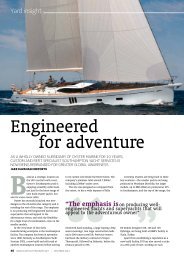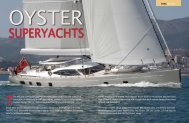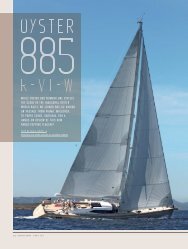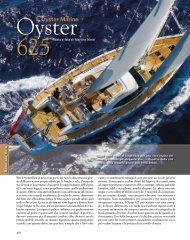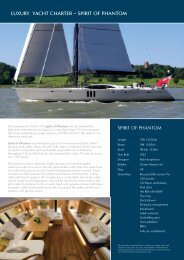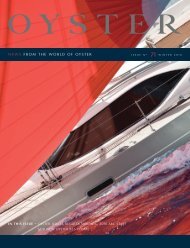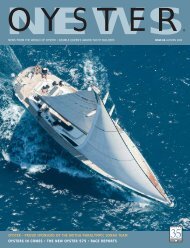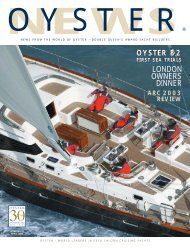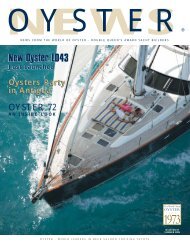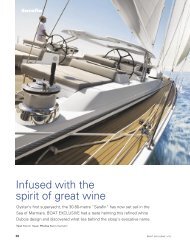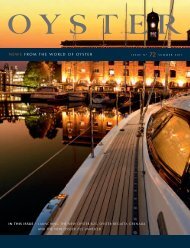You also want an ePaper? Increase the reach of your titles
YUMPU automatically turns print PDFs into web optimized ePapers that Google loves.
FACT BOX<br />
As with any sail, regular inspection of<br />
the sail for chafe and general<br />
wear and tear will be of benefit in the<br />
long run, and reduce repair bills.<br />
Particular attention should be paid to<br />
batten pockets where they may<br />
touch spreaders or shrouds. Chafe<br />
protection patches should be applied<br />
in the area of the spreaders. Carry<br />
spares in your sail repair kit.<br />
Pay particular attention when folding<br />
away mainsails ensuring battens lie<br />
flat, not twisted, and the sail is curled<br />
rather than creased along edges.<br />
Annual washing removes salt and dirt<br />
which work their way into the<br />
fibres of the sail and cause damage.<br />
After use ease the halyard, outhaul<br />
and batten pocket tensions,<br />
particularly if they have been heavily<br />
tensioned.<br />
Always cover your mainsail with the<br />
sail cover after use, particularly in<br />
areas of extended sun exposure.<br />
RECOMMENDED READING<br />
Easy reading: Looking at Sail,<br />
Bruce Banks and Dick Kenny<br />
Medium reading: The Art and<br />
Science of Sail Making, Tom Whidden<br />
Reference book level: The Aero/<br />
Hydrodynamics of Sailing,<br />
Tony Marchjai<br />
Other interesting reading:<br />
Sail Power, Wallace Ross<br />
More to do with racing but<br />
nonetheless an interesting insight:<br />
Winning in One Designs:<br />
Robert Hopkins<br />
28 www.oystermarine.com<br />
REEFING<br />
If the main is constantly<br />
backwinding and perhaps even<br />
wiping out (totally backwinding<br />
from luff to leach), it is time to<br />
consider reefing. Most boats will<br />
benefit from reducing headsail size<br />
first. Either set a reduced foot<br />
length sail or roll some headsail<br />
away. Once the headsail has been<br />
reduced to the point where the<br />
clew has reached the mast and<br />
wind conditions are still too strong,<br />
then look to reef the mainsail.<br />
Generally it is best to try and match<br />
the leach profiles of the main and<br />
headsails (see Article 1 - Headsails).<br />
If you have moved the headsail<br />
sheeting car back a little to open up<br />
the genoa leach in slightly over<br />
pressed conditions, you should try<br />
to match the leach profile of the<br />
mainsail. You can achieve this by<br />
twisting the main leach by easing<br />
the sheet or vang a little.<br />
Additionally if the headsail is eased<br />
then the main should be eased.<br />
WINDWARD SAILING MODES<br />
When sailing to windward, you<br />
should try to decide which mode<br />
you wish to sail in. There are two<br />
Good comparison of high traveller and closed<br />
leach with eased traveller and more open leach<br />
modes. Mode one when sailing close to the wind is referred to as high pointing mode. Mode two,<br />
which is still sailing close to the wind but slightly further away from it, is called footing mode. You<br />
can judge which mode by watching the mainsail's upper leach telltales.<br />
When high pointing (mode one), is desirable, the upper leach telltales should be stalling about<br />
50% of the time. This means, having applied more leach tension through the sheet and or vang,<br />
the telltales should disappear behind the main about 50% of the time. High pointing is excellent<br />
to make a weather mark or keep above another yacht’s dirty air.<br />
When footing (mode two) the upper leach telltales always stream aft. This is achieved by reducing<br />
tension on the sheet and or vang. Incidentally this is how the main should always be set when<br />
sailing off wind. Footing is slightly quicker and is best used when you know you are going to lay<br />
the mark or you believe there will be an imminent wind shift.<br />
The overall difference in speed between high pointing and footing is approximately 10% of your<br />
overall boat speed. Whilst you may seek to adopt one of the modes, by necessity you often find<br />
you are working between the two.<br />
An appreciation of why you may want to be in either mode generates a better feel for sail trim.<br />
It also helps bring an awareness of where you would like to be on the course both strategically<br />
(your position relative to the conditions) and tactically (your position relative to the other boats).<br />
In the next issue we will be looking at the art of offwind sailing with reference to spinnaker and<br />
cruising chute setting and trimming.




